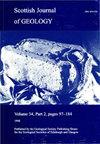Lateglacial to Holocene palaeoenvironmental change in the Muck Deep, offshore western Scotland
IF 0.5
4区 地球科学
Q4 GEOLOGY
引用次数: 2
Abstract
Shelf basins (‘glacial incisions’) can preserve a detailed record of palaeoclimatic changes due to their low-energy environment. The ‘Muck Deep’, a complex of glacially-overdeepened troughs on the Inner Hebrides shelf constitutes an example of such an environment. Five sediment cores from the Muck Deep have been analysed and related to geomorphological evidence and subsurface seismic facies. The cores show an integrated sequence of sedimentary and faunal variations from the retreat of ice (c. 17 ka) to the present day. Glacimarine sandy muds with ice-rafted debris are dated to about 11.9 cal ka BP, supporting glacial occupancy in western Scotland until the latest stages of GS-1. The transition from a paraglacial to a more stable landscape is indicated by an erosional boundary in one of the cores dated between 11.3 and 11.6 cal ka BP. Sandy sediments in a core from 200 m water depth show two upward-fining cycles and a mid-core erosional unconformity, interpreted as bottom-current deposits. Such structures do not occur in the western Muck Deep, indicating different bottom current velocities through time. A regional signal of increasing current energy at the end of the Holocene marine transgression is interpreted as the onset of modern oceanographic conditions. Supplementary material: Extra figures and table content is available at https://doi.org/10.6084/m9.figshare.c.4093997苏格兰西部近海Muck Deep的晚冰期至全新世古环境变化
陆架盆地(“冰川切口”)由于其低能量环境,可以保存古气候变化的详细记录。“Muck Deep”是内赫布里底群岛大陆架上一个由冰川覆盖过度的槽组成的综合体,就是这种环境的一个例子。对Muck Deep的五个沉积物岩心进行了分析,并将其与地貌证据和地下地震相联系起来。岩心显示了一个完整的沉积和动物群变化序列,这些变化源于冰的消退(约17 ka)直到今天。含冰椽碎屑的灰岩砂质泥岩的年代约为11.9年 cal ka BP,支持苏格兰西部冰川的占用,直到GS-1的最新阶段。从副冰川到更稳定景观的过渡由11.3年至11.6年期间的一个岩芯中的侵蚀边界指示 cal ka BP。200岩芯中的砂质沉积物 m水深显示两个向上变细旋回和一个中芯侵蚀不整合,解释为底流沉积。这种结构没有出现在西部Muck Deep,表明随着时间的推移,底部洋流速度不同。全新世海侵结束时洋流能量增加的区域信号被解释为现代海洋学条件的开始。补充材料:额外的数字和表格内容可在https://doi.org/10.6084/m9.figshare.c.4093997
本文章由计算机程序翻译,如有差异,请以英文原文为准。
求助全文
约1分钟内获得全文
求助全文
来源期刊

Scottish Journal of Geology
地学-地质学
CiteScore
1.70
自引率
0.00%
发文量
10
审稿时长
>12 weeks
期刊介绍:
Although published only since 1965, the Scottish Journal of Geology has a long pedigree. It is the joint publication of the Geological Society of Glasgow and the Edinburgh Geological Society, which prior to 1965 published separate Transactions: from 1860 in the case of Glasgow and 1863 for Edinburgh.
Traditionally, the Journal has acted as the focus for papers on all aspects of Scottish geology and its contiguous areas, including the surrounding seas. The publication policy has always been outward looking, with the Editors encouraging review papers and papers on broader aspects of the Earth sciences that cannot be discussed solely in terms of Scottish geology.
The diverse geology of Scotland continues to provide an important natural laboratory for the study of earth sciences; many seminal studies in geology have been carried out on Scottish rocks, and over the years the results of much of this work had been published in the Journal and its predecessors.
The Journal fully deserves its high reputation worldwide and intends to maintain its status in the front rank of publications in the Earth sciences.
 求助内容:
求助内容: 应助结果提醒方式:
应助结果提醒方式:


